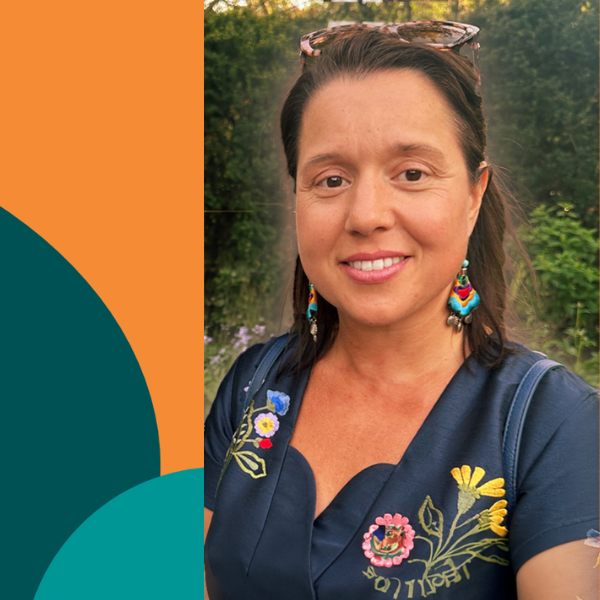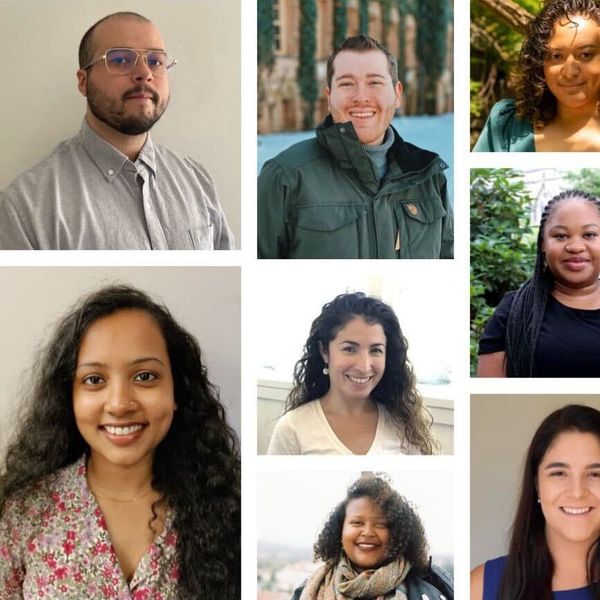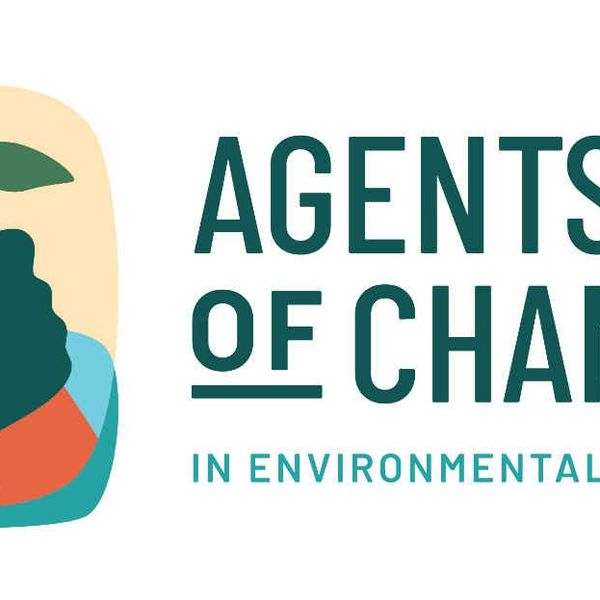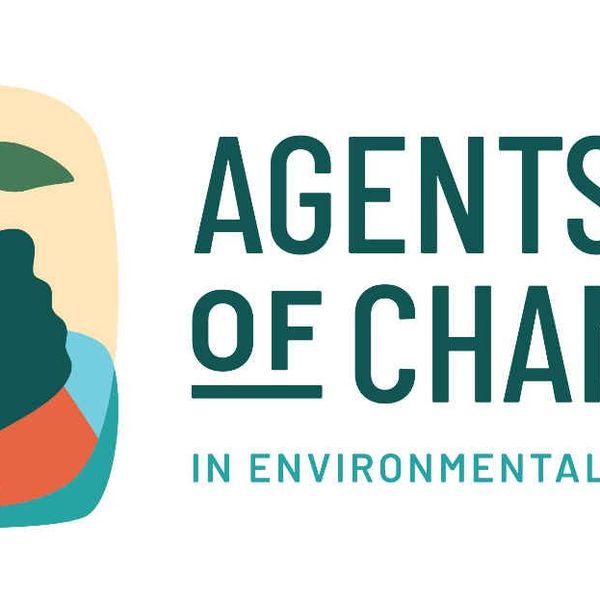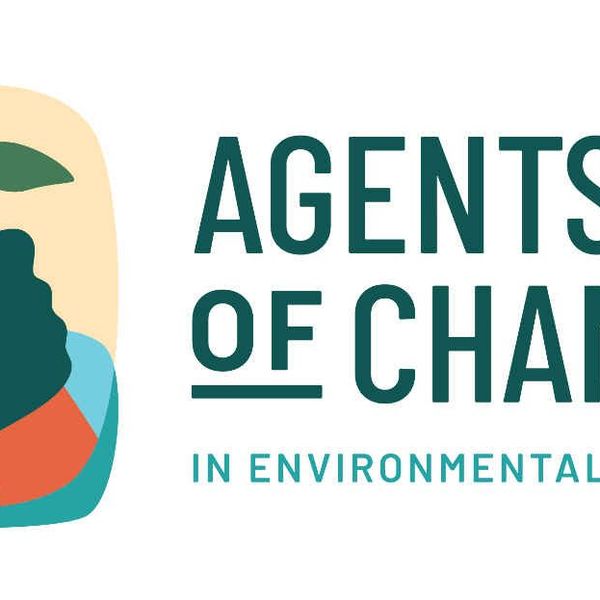Editor’s note: This story is the second of “Adrift,” a three-part series by EHN and palabra, a multimedia platform of the National Association of Hispanic Journalists, on pesticide use in California that finds rural communities of color and farmworkers are disproportionately exposed to some of the most dangerous chemicals approved for use in agriculture.
Para leer este reportaje en español haga clic aquí.
BAKERSFIELD, Calif. — Flor Alvarado is in the kitchen of her mobile home, listening intently to a virtual meeting and taking notes while Alexa and Alison, her twin seven-year-old daughters, play quietly in the living room. Alvarado lives in Bakersfield, at the bottom of California’s sweltering San Joaquin Valley, where it’s not uncommon for temperatures to reach triple digits. The air conditioner is humming trying to keep the home cool as the voice of a community activist blares from Alvarado’s phone screen. She glances at her girls; it is almost time for dinner. Alvarado joined this group to support farmworker women and prepare them for community leadership roles. It is the first of several organizations she’s joined since 2019 – a few years after the activist in her was born.
Prior to the San Joaquin Valley, Alvarado and her family lived in Oxnard, about an hour-and-a half drive northwest of Los Angeles in Ventura County, where vast fields of strawberries fill the flatlands near the coast. That’s where Alvarado changed lanes into activism after a life-threatening incident disrupted her life as a farmworker and mother.
On a December morning in 2014, while she worked in an Oxnard strawberry field, Alvarado suffered what she believes was an acute reaction to a berry she ate, laced with pesticide residue. She was three months pregnant. Not long after eating the berry, Alvarado noticed vaginal bleeding and ran to a porta-potty. Afraid and confused, she decided to go home but the bleeding would not stop. Then, rashes began appearing.
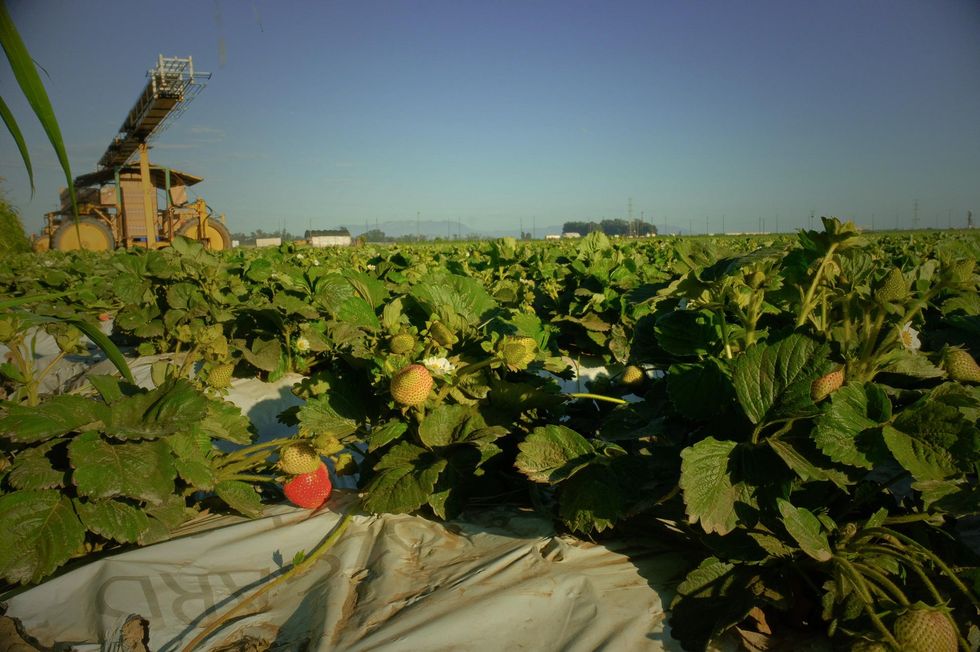
Strawberries are a major crop in Oxnard, which hosts the annual California Strawberry Festival. Non-organic strawberries undergo frequent pesticide treatment, posing risks to farmworkers and nearby residents.
Zaydee Sanchez for EHN/palabra.
Alvarado drove herself to a hospital, where a doctor told her she was at risk of losing her daughters. That’s when she learned she was having twins. The doctor advised Alvarado to stop working.
Later, Alvarado’s colleagues said the field she was harvesting that morning had been treated with pesticides over the weekend. They told her that several other farmworkers had fallen ill that same day.
Alvarado’s story resonates among California’s legions of agricultural workers, families and communities often exposed to pesticides with limited knowledge of where, when and what toxic chemicals have been used.
But now Alvarado has joined the relentless activists who have fought for pesticide reform and recently won a landmark victory: Decades of work by Californians for Pesticide Reform (CPR) and its more than 200 coalition partners led to tougher rules, and, beginning in 2024, the state will require advance notification of which pesticides will be applied to fields and when.
Today in California, public notifications alert communities to things like child abductions, wildfires and severe weather. Yet despite decades of research linking pesticides to health harm, the general public receives no advance warning when a toxic pesticide is to be applied.
That will change now that California Gov. Gavin Newsom has allocated $10 million to the California Department of Pesticide Regulation (DPR) to develop a statewide notification system. The public will have access to an online platform to find out about upcoming applications of hundreds of the most dangerous pesticides in a given area. Community advocacy was key in securing that funding in the 2021 budget, according to DPR spokesperson Leia Bailey.
While California isn’t the first state to require advance notification of pesticide applications, its system aims to be the most comprehensive and accessible. In addition to providing the public with information to protect their health, activists hope it will generate more awareness of pesticide exposure and increase public pressure to improve pesticide regulation in California and nationally.
The notification system will also provide a powerful tool for researchers and public health officials to track diseases and study possible links to pesticides, and could serve as a model for other states, said Pamela Lein, professor of neurotoxicology at the University of California, Davis.
“This notification may be incredibly important and useful to scientists to try and make associations between exposures and adverse health outcomes,” Lein said.
Having that data, she said, will allow public health researchers and officials to more easily tease out pesticides from other pollution sources.
Lein likens pesticide notification to when health officials first began campaigning about the harmful health effects of smoking cigarettes. “When you hear people that you trust to protect your health talking about this, the more likely it is that the community will…begin to get involved in protecting themselves,” she said.
The testing grounds are four communities in Ventura, Riverside, Stanislaus and Santa Cruz counties, where different versions of a notification system were piloted last year.
“We are working with several county agricultural commissioners throughout the state on voluntary pilot projects to test out different elements of system design,” said Karen Morrison, acting chief deputy director of the DPR. Morrison said an analysis of the pilot projects’ effectiveness will inform the final statewide system design.
However, in public workshops convened by DPR in November 2022, residents and advocates expressed concerns about accessibility problems with the online system. They fear the system will not provide the specific times and locations of pesticide application.
As the state considers public feedback, one settled component of the notification system is that it will only include restricted pesticides, those deemed most dangerous to public health and the environment.
“There are many pesticides that are hazardous that are not restricted,” said CPR’s co-director Jane Sellen. “It takes a long time for any pesticide to land up on that list. There’s always a little bit of a default of ‘consider it safe until proven otherwise,’ and it takes decades to prove otherwise. But we’ll take (the notification system) as a starting point.”
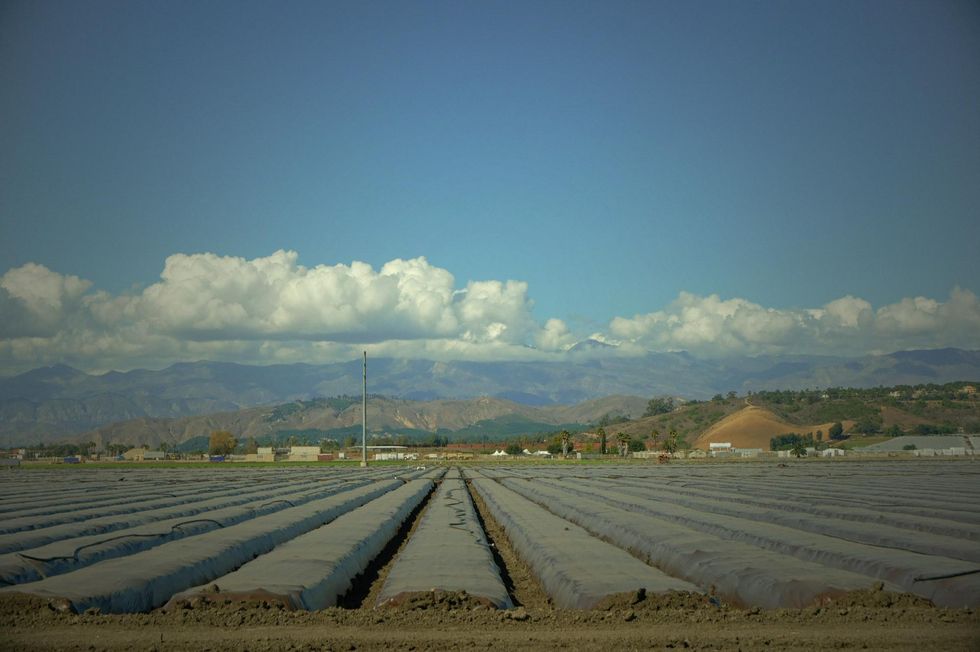
Ventura County’s annual $2 billion agricultural industry produces a variety of crops, including beans, strawberries, citrus, onions and celery.
Zaydee Sanchez for EHN/palabra.

A sign in Spanish next to Oxnard agricultural fields alerts drivers to slow down when children are present. But communities receive no advance warning about pesticide applications and their potential harm to children and others.
Photo by Zaydee Sanchez for EHN/palabra.
From farmworker to activist
Preventing other families from suffering pesticide exposure is what now drives Alvarado, who began working in Oxnard’s agriculture fields along with her mother and brother when she was 14.
Originally from the city of Pachuca, in Mexico, her family lived a life of migrant work, following the harvest seasons for strawberries, tomatoes and chili peppers, and then toiling in various crop nurseries. Alvarado said that the adverse reaction to pesticides in 2014, while she was pregnant, was not her first exposure.
“I began working in the fields at a very young age and I didn’t have an understanding of how they would spray,” she said. “On occasions, I began to notice when they would spread this white powder, my hands would get itchy and rashes would appear. My mother would tell me it was because of pesticides or the white powder, and just to put on gloves. But I knew this was strange.”
Alvarado is convinced her acute exposure in 2014, and years of working in treated fields, affected the development of her daughters. She recalls never-ending hospital visits following the birth of her twins because they were constantly ill. As her daughters grew she noticed delays in developmental milestones like walking and speaking.
“Between farmworker mothers we would share similar stories,” Alvarado said. “We would say, ‘My child is like yours, they have learning disabilities.’”

Alexa's (left) and Alison's (right) rooms are both painted pink, their favorite color. Their mother, Flor Alvarado, believes acute pesticide exposure during her pregnancy, along with years of working in treated fields, affected the girls’ development.
Zaydee Sanchez for EHN/palabra.
At the time, Alvarado had little understanding of the health effects of pesticide exposure, nor had she received any training.
“At times they would spray along where we would be working,” she said. “I would tell the mayordomo (supervisor) and he would say it was simply water for the plants or that it was to remove the powder. They would never tell us it was the spray, but it smelled awful and we knew it had to be the spray. Never did they give us anything to protect ourselves.”
California law requires employers to provide training for farmworkers working in treated fields. The training must provide information on the effects of pesticides and how workers can protect themselves.
The U.S. Environmental Protection Agency (EPA) also requires employers nationwide to provide pesticide training materials to agricultural workers through the agency’s Worker Protection Standard (WPS). In 2015, the WPS was updated, requiring farmworkers be trained yearly instead of every five years.
"Never did they give us anything to protect ourselves.”
But Alvarado said she didn’t receive any pesticide training from her employer until 2019. “The training meetings would only last about five minutes,” she said. “They give you a chart and say ‘sign’ so it’s documented you received the training.”
Around the time of her first pesticide training session, Alvarado decided to get involved in pesticide reform.
Pesticide exposure: Knowledge is power
Pesticides have long been linked to chronic human health problems like cancer, premature birth, autism and damage to the brain and nervous system. California is the nation’s leading farm state, with some $51 billion in revenue. It also leads the country in pesticide applications, with more than 200 million pounds used each year.
Many in industrial agriculture say pesticides are essential to preventing losses to bugs, diseases and weeds. However, farmworkers, union leaders and health experts for decades have warned of the consequences of pesticide exposure – above all for Latino and Indigenous migrants who dominate the ranks of farm laborers. An estimated 500,000 to 800,000 farmworkers work the fields in California each year, and 83% identify as Hispanic or Latino. A 2022 study published in the journal BMC Public Health found that all pesticide use in the state occurs in the 60% of California zip codes that are home to the highest percentages of people of color.

Alvarado and her daughters recently moved from Oxnard to Bakersfield, in the San Joaquin Valley. One of the perks of their new home is the community playground.
Zaydee Sanchez for EHN/palabra.
Public health experts say advance notification would help workers and residents protect themselves.
“If public health officials were to announce that we have been alerted to the fact that pesticide X, Y, Z is going to be sprayed in this sector or this particular community on these dates, we would urge everybody within a certain mile radius of this application to minimize your time outdoors,” said Lein. “We would ask to make sure that you close your windows. That if you do go outdoors, wear a mask and to wash your clothes thoroughly. And if you have respiratory disorders to be particularly careful.”
Alvarado believes it will also help farmworkers understand their rights. “As a farmworker, one obeys the person in charge, but if you hear another opinion, you say, ‘I can’t do that. There are laws that protect me.’”
Lein said the notification system has potential in reducing health harm from pesticide exposure – particularly acute effects like those experienced by Alvarado. “I think we do have a real chance to see a reduction in adverse health effects associated with acute exposures.”
A hard-fought change
The fight for the new notification system started in 1996, when the CPR organization was founded. What brought activists together under the CPR banner was the defeat, in 1990, of California’s Proposition 128, known as “Big Green.”
The Big Green measure proposed to eliminate dozens of pesticides, but voters statewide rejected it. Its defeat would lead to the founding of CPR.
“The realization was we have to pull everyone together and have a singular focus on pesticides,” Sellen said.
Success followed, including the passing of statewide policies like school buffer zones in 2017, which prohibit daytime pesticide applications within a quarter mile of schools and childcare facilities. In 2019, California outlawed virtually all agricultural use of the toxic chemical called chlorpyrifos – first developed by Nazis for warfare. Expansive research linked chlorpyrifos to brain damage and birth health defects in children. Alongside these victories, the idea of a pesticide notification system was resurrected.
“The realization was we have to pull everyone together and have a singular focus on pesticides.”
The first test of notification protocols would take place in Shafter, a small, predominantly Latino city northwest of Bakersfield. Surrounded by cotton fields and pistachio and almond orchards, the city is sandwiched between Interstate 5 and Highway 99, in the Central Valley’s southern lowlands.
In 2017 the state passed a landmark law, AB617, aiming to reduce air pollution in disadvantaged communities and provide funding to support community participation in solutions. Residents and local environmental groups like the Central California Environmental Justice Network (CCEJN) successfully pushed the state to include Shafter, which suffers agricultural, traffic and oil and gas pollution.
Grassroots organizers in Shafter fought hard for a local pesticide notification system, and the California Air Resources Board allocated $250,000 to build it.
“That was a big, big win,” Sellen said. “Well, then Kern County agriculture commissioner, Glenn Fankhauser, just straight up refused.”

Gustavo Aguirre, Jr., former Kern County director of the Central California Environmental Justice Network, advocated for a local pesticide notification system in Shafter, a small agricultural community near Bakersfield.
Zaydee Sanchez for EHN/palabra.
In California, county agriculture commissioners, appointed by county officials but working under state pesticide regulators, are responsible for enforcing state agriculture regulations. Pesticide monitoring represents 60% of their workload.
“We’ve got a very complicated jurisdictional authority over ag commissioners,” Sellen said. Shafter organizers pressured Fankhauser to implement the local pesticide notification system, but failed.
Palabra and EHN sat down with Fankhauser in his Bakersfield office to ask about pesticide application notifications.
While Fankhauser acknowledged that there may be a public “right-to-know” argument for a notification system, he said he doesn't regard it as an effective tool for protecting community health. “I don’t believe it is going to solve any pesticide exposure issue,” he said.
Despite Fankhauser’s opposition to a local notification system, Sellen said Shafter “blazed a trail for a way to actually do it” and the continuous pressure from CPR and partners finally led to funding for a statewide system.
“I think when Shafter failed, it applied so much political pressure…to create a statewide system,” said Sellen. “The state was going to have to exercise leadership and that was going to take a lot of political capital.”
“We’ve got a very complicated jurisdictional authority over ag commissioners."
Fankhauser opposed the statewide system as well, but he said now that the state has moved forward with implementation, he has no problem complying. However, Shafter will not be a pilot site for the statewide system.
The defeat in Shafter stung community members who had fought for notification, said CCEJN’s former Kern County director, Gustavo Aguirre, Jr. “Essentially the state came back and said, ‘Congratulations, because of you guys we have a statewide notification. But we’re going to do this outside of the valley. And then, once it’s statewide implemented, then it’s going to benefit you.’ This is the injustice that these communities are unfortunately used to.”
Along with Kern County, other San Joaquin Valley officials in Tulare, Fresno, San Joaquin and Madera counties also declined participation in the pilot project. They are among nine counties that collectively comprise the most productive agricultural region in the world – and also have the largest pesticide usage.
Stanislaus County, known for its wineries and expansive almond orchards, is the only county in the valley participating in the pilot project, but not without controversy.
A crop of community concerns

Agriculture fields border the Oxnard, California neighborhood of Nyeland Acres. The community is participating in a pilot project that will inform the design of the statewide pesticide notification system.
Zaydee Sanchez for EHN/palabra.
The Stanislaus project is underway in Grayson, a small town of just over 1,500 people – almost all Hispanics – about 15 miles southwest of Modesto. Grayson is surrounded by farms, with the San Joaquin River running to the west and Highway 33 to the east.
Bianca Lopez, co-founder of the organization Valley Improvement Projects for Social and Environmental Justice, said she’s grateful that Stanislaus County agricultural commissioner Kamaljit K. Bagri volunteered for the pilot project. But, Lopez said, “If we’re going to do a pilot program, then let’s do it right.”
Community members said they’ve stressed the importance of including exact locations of planned pesticide applications. They also want an easy-to-navigate online platform where communities can find the name of the pesticide, its known or suspected health effects and scheduled application times. They hope the final version of the platform can be provided in different languages to better reach speakers of Spanish and Indigenous languages.
Lopez said Grayson residents find the pilot website, which requires registration with a log-in password, cumbersome, and are disappointed that it doesn’t provide the exact locations of pesticide applications. “So it’s basically telling me what I already know. That we are being sprayed on, at all hours of the day. It didn’t give us any additional information about the true location of the application.”
Similar problems have affected Ventura’s County pilot notification project, launched last spring, in the Oxnard neighborhood of Nyeland Acres. The predominantly Latino community is bordered by the 101 Ventura Freeway to the east, nursery crops to the north and fruit and vegetable fields to the south. Residents have been reluctant to register for the pilot notification project, said CPR community organizer Teresa Gomez, because it fails to provide precise locations of pesticide applications.
She added that the notification sign-up system asks for information that not everyone is comfortable giving. Because an estimated 75% of California farmworkers are undocumented, many fear repercussions from sharing personal information.
Asked why exact spray locations are not provided in the pilot programs, DPR’s acting chief deputy director, Karen Morrison, said she hears the community’s concerns and the state is “considering that information as (it is) looking towards statewide system design.”
It’s a start

Alexa draws with her favorite bird stuffed animal perched on her shoulder. The seven-year-old suffers from hearing loss but has been unable to undergo surgery due to the pandemic shutdown.
Zaydee Sanchez for EHN/palabra
Organizers like Flor Alvarado also worry about what will be left out of the eventual statewide notification system. But it won’t stop her activism.
In her Bakersfield mobile home, as the organizer meeting comes to an end, summer sunlight cuts through curtains. Her daughter Alexa points out a white apron she helped decorate with her mom and sister that reads, “Líderes Campesinas Ventura (Women Farmworker Leaders of Ventura).” The family shifts to preparations for another community meeting that will take place over the weekend in Oxnard, a two-hour drive south.
Looking at Alexa, Alvarado recalls that after her daughters were born, she returned to work in Oxnard’s farm fields. She remembers her mother constantly suffering from headaches, nausea and vomiting – so much so that she would have to take work breaks every four to five hours. Soon Alvarado began to feel immense headaches herself. She said she would come home after work, take a pain pill, shower and go straight to bed.
As Alvarado opens the fridge in search of dinner fixings, Alexa and Alison run in and out of their rooms. Each girl’s room is painted pink, and posters of Elsa from the movie “Frozen” decorate their walls. Coloring books and pencils cover their rug as they begin sharing ideas about what each should draw.
Alvarado said her twins have suffered developmental delays. They didn’t begin to walk or speak until the age of two. Both girls suffer from hearing loss; Alison was able to undergo surgery for the condition, but because of the COVID-19 pandemic, Alexa’s procedure was postponed. Once the twins began school, Alvarado said, a specialist examined her daughters and confirmed that they had learning disabilities. Many pesticides are linked to low birth weight, miscarriage, premature birth and later cognitive problems in children.
As the sun sets over Bakersfield, Alvarado turns on the kitchen lights. She begins to clear the dining table of the coloring books that Alexa and Alison brought in. She grabs her Líderes Campesinas apron and places it on her clean kitchen hightop.
She’s beginning to get her mother and sister involved, too. “At first my mother didn’t like that I was an organizer, but now she calls me to tell me when they are spraying while she’s out working in the fields,” Alvarado said. “I tell her, ‘take pictures, take pictures of everything.’”
- Op-ed: Ever heard of isoxaflutole? That’s about to change ›
- LISTEN: Denise Moreno Ramírez on protecting workers in auto shops and beauty salons from toxics - EHN ›



















